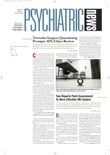The U.S. Food and Drug Administration has approved the vagus nerve stimulation (VNS) device as a new therapeutic option for patients who have severe depression and who have not responded to multiple courses of standard antidepressant therapies.
In a rare move, Daniel Schultz, M.D., director of the FDA's Center for Devices and Radiological Health, signed the approval letter to Houston-based Cyberonics Inc. Approval letters are usually signed by the appropriate director or deputy director of the division that has jurisdiction over the device's or drug's class.
The VNS system has been the focus of controversy almost from the point that Cyberonics submitted its original application to the FDA in October 2003. FDA staff reviewers working under Schultz originally deemed the device“ nonapprovable.” Reviewers were concerned about the company's data from the short-term clinical trials indicating relatively low levels of response to the VNS system and several suicide attempts, including at least one completed suicide.
Cyberonics appealed the nonapprovable decision, submitting supplemental data on longer-term efficacy and safety. The FDA's Neurological Devices Panel—an advisory group of outside experts—then voted 5-2 in June 2004 to recommend approval of the device (Psychiatric News, July 16, 2004).
The disagreement between the FDA's internal review and the advisory group's recommendation prompted outrage from the patient advocacy group Public Citizen and sparked a review of the FDA's handling of the application by the Senate Finance Committee (Psychiatric News, June 17).
In the end, the FDA approved the VNS device “for the adjunctive long-term treatment of chronic or recurrent depression for patients 18 years of age or older who are experiencing a major depressive episode and have not had an adequate response to four or more adequate antidepressant treatments.”
The VNS system requires surgical implantation of the stimulator—similar to a cardiac pacemaker—in the patient's left shoulder. The surgeon must tunnel an electrode from there to the neck through the subcutaneous tissues to the vagus nerve. The electrode is then wrapped around the left vagus nerve, and the opposite end is attached to the device and turned on. The device is programmable with a handheld computer that communicates with the device by radio signals.
Because of the complexity of the procedure and skills required to implant and program the VNS device, the FDA's final approval included several of the recommendations made by the Neurological Devices Panel. The panel had strongly recommended a very narrowly defined treatment population in which VNS could be used and stipulated that the device could be implanted and monitored only by physicians specifically trained and qualified to do so.
Adverse reactions associated with the surgical implantation procedure include bleeding, infection, pain at the incision site, failure of the incision to heal, possible eruption of the device through the skin, possible breakage or disconnection of the lead, and vagus nerve damage.
The most common treatment-emergent adverse effects noted in clinical trials of VNS for depression included (after nine to 12 months of therapy) voice alterations (54.1 percent), shortness of breath (16.3 percent), neck pain (12.9 percent), cough (6.2 percent), and pharyngitis (5.3 percent).
The FDA's approval was based on data from four clinical trials submitted by Cyberonics. For example, one trial was a 12-week, acute-phase feasibility study with long-term follow-up. Fifteen percent of the subjects were responders, having achieved at least a 50 percent reduction in their depression scale scores. At the one-year mark, 27 percent were responders, and at two years, 21 percent were responders.
The FDA's Schultz was not available for an interview with Psychiatric News; however, he told the Wall Street Journal that in the clinical trials he saw a “consistent, long-term response that is quite striking” for a “very, very sick, end-stage population” of patients who have “run out of standard options for the treatment of a serious condition.”
FDA information on the Cyberonics VNS Therapy System, including the approval order and a summary of safety and effectiveness, is posted at<www.fda.gov/cdrh/pdf/p970003s050.html>.▪
